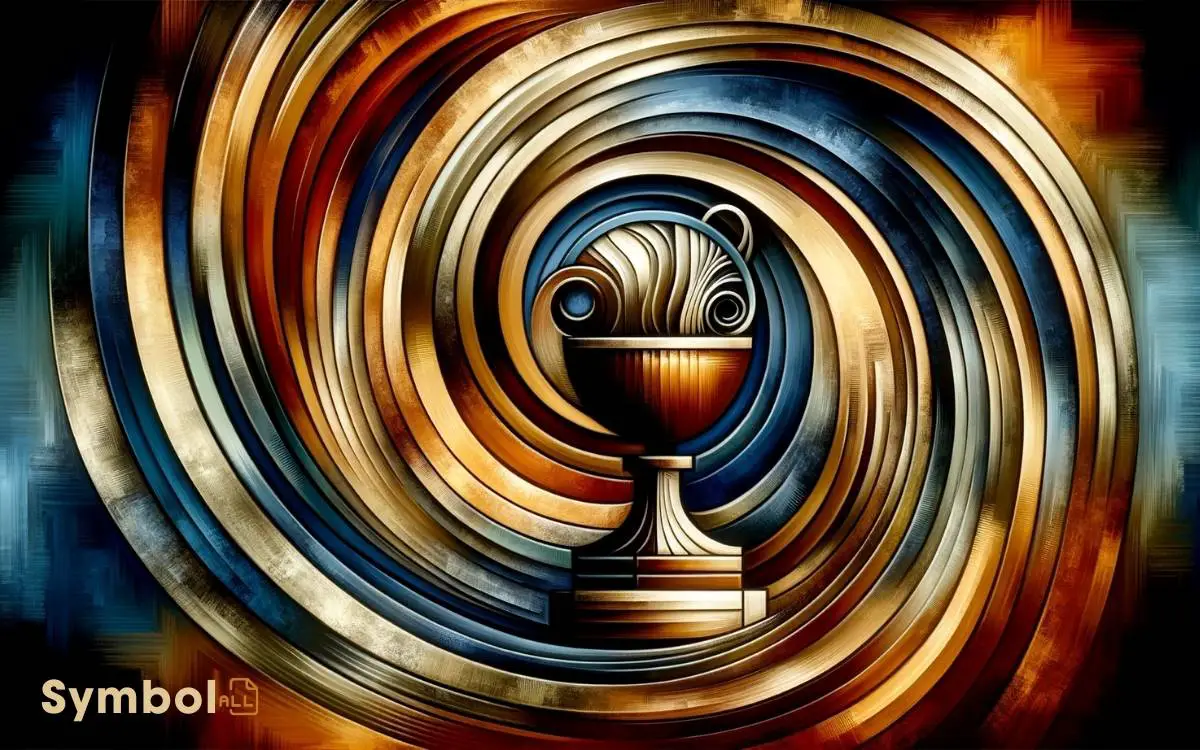What Does the Color Bronze Symbolize? Strength!
When you think of bronze, you’re tapping into a legacy of resilience, durability, and earthy connection. This color doesn’t just speak to the material’s robust composition but also to its longstanding significance in human history.
Bronze symbolizes enduring strength, steadfastness, and a unique blend of beauty that has lasted ages. It ties you to the practical achievements and artistic expressions of ancestors, underlining a deep connection to the earth through its copper and tin makeup.
In art, its warm hues add depth, hinting at both timelessness and the evocation of a sophisticated taste. There’s a lot more to uncover behind this color’s rich symbolism, inviting a deeper exploration of its cultural and spiritual meanings.

Key Takeaways
Historical Significance
Throughout history, bronze has symbolized resilience and durability, reflecting its widespread use in tools, weapons, and sculptures by ancient civilizations.
This enduring material hasn’t only conveyed strength but also served as a medium for cultural expression, capturing the essence of societies that flourished thousands of years ago.
Its significance extends beyond the physical, embodying the achievements and advancements of our ancestors.
You’ll find that bronze artifacts, from the majestic statues that grace museums to the simple tools unearthed in archaeological digs, tell a story of human innovation and artistic endeavor.
These objects aren’t just demonstrations of the past; they’re indications to the ingenuity and resilience of civilizations that have shaped the course of history, offering insights into the complexities of human development and cultural identity.
Strength and Durability
Bronze’s composition imbues it with unmatched strength and durability, qualities that have cemented its role in human progress.
You’ll find that its symbolism extends beyond mere physical attributes to represent the resilience and steadfastness required to overcome life’s challenges.
| Quality | Symbolism | Application |
|---|---|---|
| Strength | Resilience | Architecture |
| Durability | Longevity | Sculptures |
| Corrosion Resistance | Preservation | Marine Hardware |
This table illustrates how bronze’s physical properties translate into symbolic meanings. Its strength reflects our inner resilience, its durability symbolizes the longevity of our endeavors, and its resistance to corrosion represents the preservation of our core values over time.
Through this lens, bronze isn’t just a material; it’s a metaphor for enduring strength and unwavering commitment in the face of adversity.
Connection to Earth
Moving beyond its physical attributes, let’s explore how bronze’s inherent connection to the earth shapes its symbolic meanings.
This metal, an alloy primarily of copper and tin, is deeply rooted in the earth both literally and metaphorically.
Its extraction and refinement process ties it intrinsically to the soil and underground domains, symbolizing a profound bond with our planet. This connection suggests stability, reliability, and a sense of grounding.
When you consider bronze’s symbolism, it’s not just about its durability or aesthetic appeal; it’s about recognizing its earthly origins. This recognition imbues bronze with a sense of resilience and adaptability, reflecting the earth’s own enduring nature. ]
Through this lens, bronze embodies the earth’s qualities, reminding us of our own connection to the natural world.
Symbol of Third Place
In recognizing athletic achievement, you must understand how bronze symbolizes third place, shaping competitive hierarchies.
This metallic color not only marks a distinct level of achievement but also clearly demarcates the shift from elite to highly commendable performances.
Athletic Achievement Recognition
When discussing athletic achievement, bronze conspicuously symbolizes the commendable feat of securing third place in competitions. This recognition extends beyond mere placement; it embodies perseverance, skill, and dedication.
You must appreciate that athletes who achieve this honor have surpassed numerous contenders, showcasing remarkable talent and resilience. Bronze, accordingly, isn’t simply a marker of third place but a validation of the athlete’s journey and the challenges they’ve overcome.
Analyzing this from a methodical perspective, the awarding of bronze medals emphasizes the value of aiming for excellence and the acknowledgment of effort, not just victory. It encourages competitors to push their limits, fostering a spirit of continuous improvement.
To put it simply, the symbolism of bronze in athletic contexts serves to inspire both participants and spectators, highlighting the broader significance of commitment and achievement in sports.
Competitive Hierarchies Established
The assignment of bronze as a symbol for third place in competitions establishes a clear competitive hierarchy, recognizing not only the pinnacle of achievement but also the valor and excellence of those who nearly reached the summit.
This hierarchical structure, represented by gold, silver, and bronze, meticulously categorizes competitors based on their performance, yet it’s the bronze that intriguingly captures the spirit of persistence and hard-fought battles.
- Bronze evokes a sense of enduring strength in the face of adversity.
- It symbolizes the bitter-sweetness of coming close, yet being just out of reach of the top.
- Bronze represents a tangible acknowledgment of effort and skill.
- It inspires future endeavors, signaling that the journey doesn’t end here.
- Finally, bronze immortalizes the relentless human spirit, always aiming for excellence.
Artistic Representations
In exploring the artistic representations of bronze, you’ll notice that sculptures and paintings often utilize bronze tones to evoke specific feelings and themes.
By examining the use of bronze in sculptures, you observe its role in conveying durability and timelessness, a demonstration of the material’s historical significance.
Similarly, when you consider its application in paintings, bronze tones add depth and warmth, creating a unique aesthetic that enriches the artwork’s overall impact.
Bronze in Sculptures
Many artists choose bronze for their sculptures due to its durability and visually appealing patina, which adds depth and character to artistic representations.
This choice isn’t merely practical; it’s deeply symbolic, reflecting a blend of strength, resilience, and timelessness that bronze conveys. When you encounter a bronze sculpture, it’s not just the form that speaks to you, but the material itself.
- The enduring nature of bronze symbolizes permanence in the fleeting world.
- Its patina reflects the beauty of aging, embracing change gracefully.
- The weight of bronze sculptures imparts a sense of gravity and significance.
- Bronze’s resistance to corrosion mirrors the idea of overcoming adversity.
- The warm hues of bronze sculptures evoke a connection to the earth, grounding the viewer.
Analyzing bronze in sculptures reveals how material choice significantly influences the emotional and psychological impact of artwork.
Paintings Bronze Tones
Shifting our focus to the world of paintings, it’s remarkable how artists incorporate bronze tones to evoke a spectrum of emotions and themes, mirroring the symbolism found in bronze sculptures.
When you explore deeper into the palette of an artist, you’ll notice that bronze tones aren’t just chosen arbitrarily. They’re meticulously selected to convey durability, resilience, and an enduring beauty that transcends the ages.
The warm, rich hues of bronze can bring a painting to life, adding depth and a sense of permanence. As you investigate various artworks, you’ll find that these tones often underscore scenes of historical significance or portray figures of strength and honor.
Analyzing paintings with bronze tones offers you a unique lens through which to interpret an artist’s message, providing insights into the human condition and our collective past.
Resilience and Perseverance
Reflecting on the color bronze, you’ll find it embodies resilience and perseverance through its association with age-old tools and weapons that have withstood the test of time.
This deep connection to endurance is symbolically significant, suggesting that whatever is tinged with bronze carries a legacy of overcoming challenges.
- Bronze reminds us that struggle precedes victory.
- It symbolizes the beauty in aging, not just survival.
- The color encourages steadfastness in the face of adversity.
- It represents an unyielding spirit, much like the metal itself.
- Bronze evokes a sense of timelessness, connecting past and present endurance.
Analyzing bronze in this light, you’re invited to view resilience not just as a proof but as a tribute to human spirit and ingenuity.
Wealth and Prosperity
Bronze, often synonymous with third-place finishes, also carries rich connotations of wealth and prosperity that merit a closer examination. This association isn’t merely superficial; it’s deeply ingrained in history and culture.
You’ll find that societies ancient and modern have cherished bronze for its luxurious sheen and enduring qualities, symbolizing not just transient wealth but lasting prosperity.
| Aspect | Significance |
|---|---|
| Historical | Valued in ancient cultures |
| Cultural | Sign of affluence |
| Aesthetic | Luxurious sheen |
| Durability | Symbolizes lasting wealth |
| Perception | Associated with high status |
Understanding bronze’s symbolism requires recognizing its multifaceted roles in conveying opulence and financial stability, reminding us that its value extends far beyond the podium.
Industrial and Decorative Uses
Beyond its symbolic significance, bronze plays a pivotal role in both industrial applications and decorative arts, blending functionality with aesthetic appeal. In the industrial domain, you’ll find bronze components in machinery where durability and corrosion resistance are paramount.
Meanwhile, in the decorative arts, bronze’s warm, glowing hue brings life to sculptures and ornaments, enchanting the beholder’s eye.
- Bronze bearings and bushings reduce friction in heavy machinery, ensuring longevity.
- Marine hardware made of bronze resists the corrosive sea environment, safeguarding vessels.
- In sculpture, bronze captures the fluidity of motion, freezing moments in time.*
- Architectural details in bronze, from door handles to light fixtures, add elegance to spaces.*
- Custom-made bronze jewelry pieces celebrate individuality, blending artistry with personal expression.
Cultural Meanings
Throughout various cultures, bronze has amassed a multitude of meanings, each echoing the values and beliefs of its people. In ancient civilizations, it symbolized strength and durability, reflecting its widespread use in tools and weapons.
This association lent it a sense of reliability and resilience, qualities highly valued by societies dependent on these materials for survival and advancement.
Additionally, in artistic domains, bronze represents a blend of beauty and permanence, signifying the human desire to leave a lasting legacy through creations.
Its luster and enduring nature make it a favored medium for sculptures and monuments, embodying the cultural heritage and achievements of a community.
As a result, bronze carries a rich tapestry of cultural significance, from practical utility to artistic expression, deeply woven into the fabric of human history.
Transition and Change
In the domain of symbolism, bronze’s significance evolves, signaling periods of metamorphosis and evolution that mirror society’s journey and growth.
This metallic hue encapsulates the essence of transformation, embodying the inevitable shifts we all face. Its resonance with change is profound, offering insights into the cyclical nature of life and the progression of time.
- Bronze reminds you that change is constant, urging you to embrace growth.
- It symbolizes the shift from one state of being to another, highlighting life’s dynamism.
- This color encourages resilience amidst transformation, reinforcing your ability to adapt.
- It reflects society’s evolution, marking milestones in human advancement.
- Bronze serves as a beacon of hope during periods of evolution, suggesting that with every end, a new beginning awaits.
Analyzing bronze in this light reveals its deep connection to the themes of transformation and change, framing it as a guide through life’s perpetual flux.
Spiritual and Mystical Aspects
Delving into the spiritual and mystical aspects, bronze holds a unique place in various cultures as a symbol of divine connection and esoteric wisdom. This metal, with its warm, earthy hues, often represents grounding and stability in spiritual practices.
It’s not just a conduit for physical energy but also for spiritual energy, facilitating a deeper understanding and connection to the divine.
In many traditions, bronze objects are used in rituals and ceremonies to enhance communication with spiritual spheres, suggesting that this material can bridge the earthly and the divine.
You’ll find that its presence in religious artifacts and sacred spaces isn’t coincidental but deeply rooted in its ability to embody spiritual strength and resilience.
Analyzing bronze’s role reveals its significance beyond the physical, extending into spheres of spiritual enlightenment and mystic knowledge.
Military and Honor
In the domain of military and honor, bronze holds a distinct place, particularly in the form of valor recognition medals. Its use in awards signifies not only historical military significance but also a deep respect for bravery and sacrifice.
You analyze how this color’s symbolism in medals reflects a broader narrative of honor and remembrance within military traditions.
Valor Recognition Medals
Bronze, often associated with third place in competitions, takes on a profoundly different significance in the context of valor recognition medals, symbolizing unwavering courage and commendable service.
When you explore into the domain of military honors, the bronze color isn’t just a marker of third place; it embodies the highest respect for bravery and sacrifice.
- *Bronze reflects the resilience and strength of those who’ve faced unimaginable challenges.*
- *It signifies the honor bestowed upon individuals who’ve gone above and beyond the call of duty.*
- *The color represents a tangible acknowledgment of heroic deeds.*
- *Bronze evokes a sense of solemn gratitude for the sacrifices made.*
- *It’s a symbol of the enduring legacy left by the recipients for future generations.*
Historical Military Significance
Throughout history, bronze has served as a powerful emblem of military valor and honor, symbolizing the profound respect nations hold for their warriors’ sacrifices and bravery.
This rich, earthy color embodies the resilience and enduring strength of soldiers, reflecting their unwavering commitment and steadfast spirit in the face of adversity. This hue serves as a powerful reminder of the sacrifices made and the determination required to overcome life’s challenges. Much like the meaning of turquoise color symbolism, which is often associated with tranquility and protection, this earthy tone conveys a sense of grounded stability and inner fortitude. Together, they highlight the balance between strength and calmness needed to navigate even the toughest times.
When you investigate military traditions, you’ll find that bronze often adorns medals and insignias, recognizing acts of heroism and distinguished service. It’s not just a color; it’s a tribute to the valor and sacrifices of those who’ve served.
Age and Antiquity
Evoking a sense of age and antiquity, the color bronze carries with it the weight of centuries past and the patina of time-worn artifacts. This rich hue, deep and complex, isn’t just a confirmation to durability; it’s a narrative woven from the threads of history.
When you encounter bronze, you’re touching a story that began in ancient civilizations, its significance undimmed by the passage of time.
- It whispers tales of old, forgotten worlds.
- It stands as a marker of enduring strength.
- It reflects the beauty in aging, not just as decay but as transformation.
- It embodies the resilience of cultures and ideas long passed.
- It serves as a bridge, connecting us to the legacy of human ingenuity.
In analyzing bronze, you’re delving into a profound legacy, understanding not just a color, but the age it represents.
Healing Properties
Beyond its historical significance, bronze also harbors healing properties that have been recognized and utilized across various cultures.
You’ll find that in ancient times, bronze was believed to possess qualities that could improve mental health and physical well-being.
By delving deeper, it’s evident that these properties aren’t merely based on superstition but are grounded in the metal’s unique composition.
Bronze, an alloy of copper and tin, naturally interacts with the body when worn as jewelry or held, promoting a subtle balance in the body’s energies.
This interaction is thought to stimulate the immune system and encourage the healing of wounds, both physical and emotional. Methodically, cultures have harnessed these attributes, integrating bronze in therapeutic practices aimed at holistic healing.
Modern Interpretations
In today’s world, the color bronze has taken on a multitude of meanings, reflecting societal values and cultural shifts. It’s no longer just a third-place medal or an antique material; it symbolizes much more in the modern context.
You’ll find that bronze is a representation of durability, resilience, and a connection to the Earth. Its warm, sophisticated hue suggests a blend of tradition and contemporary elegance, making it a favored choice in fashion and interior design.
- Durability: Emphasizes lasting value and quality.
- Resilience: Inspires strength in adversity.
- Earth connection: Draws us closer to nature and its grounding effects.
- Sophistication: Conveys a sense of refined taste.
- Tradition meets modernity: Bridges the gap between the old and the new, blending history with innovation.
Conclusion
In your journey through the rich tapestry of bronze symbolism, you’ve uncovered layers of meaning, from its historical weight to its embodiment of resilience and connection to the earth. Coincidentally, isn’t it intriguing how these attributes mirror the human experience?
We endeavor for strength, endure over time, and seek a harmonious relationship with our environment. Bronze, in its timeless allure, reflects our own aspirations and challenges, offering a profound reminder of our collective resilience and the beauty in our shared struggles and triumphs.






